The 6 Best Sous Vide Cookers, Tested and Reviewed
Dotdash Meredith and Yahoo Inc. may earn commission or revenue on some items through the links below.
Level up your cooking with these easy-to-use, ultra-modern appliances.
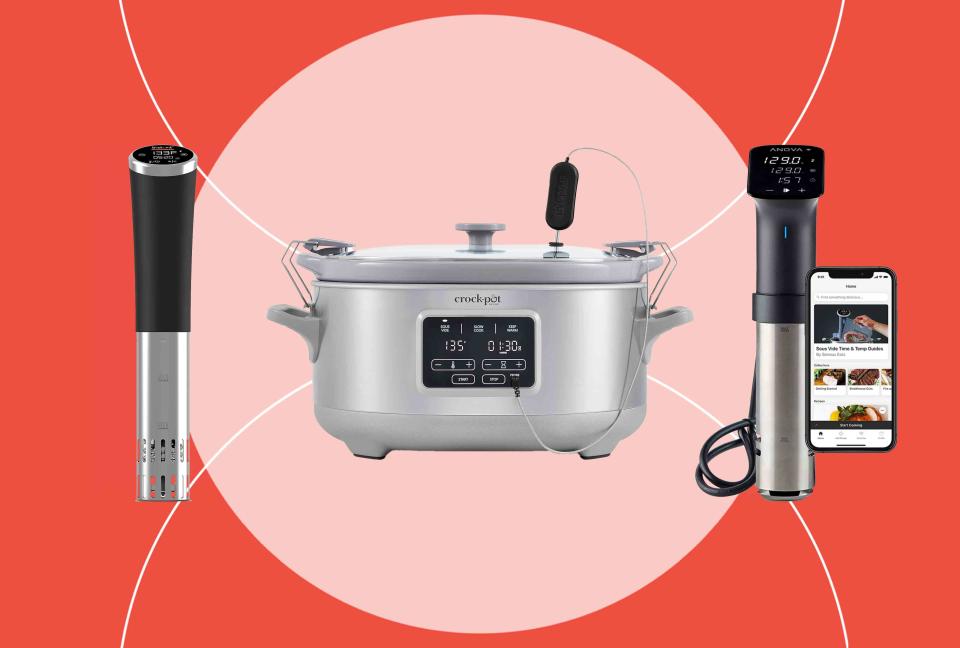
Courtesy of Brand
Reviewed by Dietitian Brierley Horton, M.S., RD
“Sous vide” may sound like a complicated culinary term best suited for chefs and formally trained professionals. But in reality, it’s an approachable cooking method for practically any home cook. Sous vide cooking involves slowly bringing food up to temperature via a water bath—a process that’s “easy and almost foolproof,” according to New York City-based registered dietitian Sherrie Shen, M.S., RDN, C.D.N.
Shen adds that sous vide can also be a healthier way to cook your food. “In terms of nutritional benefits and overall health, foods cooked in the sous vide method hold more nutrients (vitamins and minerals) compared to traditional cooking methods,” says Shen. Research published in 2020 in the journal Foods, found that compared to steaming, boiling or microwaving vegetables, the sous vide method protects and preserves nutrients sensitive to heat, oxidation or dissolve in water. For example, carrots cooked via sous vide maintained more carotenoids (the healthful compounds that give carrots their orange hue). And green beans that were sous vide cooked lost only a small amount of vitamin C while green beans that were boiled lost 50 percent of their vitamin C.
In order to cook via the sous vide method, you’ll need a quality sous vide cooker. We rounded up 21 popular models and conducted multiple rounds of rigorous testing to determine which ones were worth the investment. Keep reading to find the top four sous vide machines that we stand behind for every kitchen creative.
Our Sous Vide Cooker Recommendations
Best Overall: Anova Culinary Sous Vide Precision Cooker
Best Budget-Friendly: Inkbird Sous Vide Cooker
Best Upgrade: Anova Culinary Sous Vide Precision Cooker Pro
Best for Beginners: Instant Pot Accu Slim Sous Vide Precision Cooker
Best Overall Sous Vide Water Oven: Crock-Pot Programmable 7-Quart Cook & Carry Slow Cooker with Sous Vide
Best Splurge Sous Vide Water Oven: VacPak-It SVC100 2.6 Gallon Thermal Sous Vide Circulator
What Is Sous Vide, Exactly?
Sous vide machines have revolutionized home cooking, providing precise temperature control to achieve consistently perfect results. Like many other cooking techniques, sous vide originated in France—in fact, the term “sous vide” translates to “under vacuum” in French. As it was developed into a reliable cooking method, sous vide gained popularity in professional kitchens worldwide. Since then, it has become a reliable cooking method for home cooks looking to create meals with precision and enhance flavors and texture.
Also known as “immersion circulators” or “sous vide machines,” sous vide cookers work by slowly cooking vacuum-sealed food in a water bath at a precise temperature for a sustained period of time. Whereas cooking on a pan or grill uses a very high temperature to heat ingredients from one side at a time, sous vide brings everything to the same temperature all at once. This lets you achieve perfectly even cooking while also retaining fats, juices and nutrients that would otherwise cook out of the food.
“The great thing about sous vide cooking is that the temperature of the cooking environment (the water bath) is the same temperature you want the interior of your food to come to,” says Chelsea Cole, a food blogger and author of cookbooks Everyday Sous Vide and Sous Vide Meal Prep. “This means it's nearly impossible to overcook your food.”
“Because of how well the water conducts the heat, you can control temperatures to within a tenth of a degree,” says Rich Rosendale, certified master chef and co-founder of Atlanta, Georgia’s R3 Rosendale Concepts. “This allows you to manage the cooking process much more accurately than with traditional cooking methods.”
How to Sous Vide
Cooking via the sous vide method is easy—but the first step is determining which type of sous vide cooker you need. There are currently two types of sous vide machines out there: immersion circulators and water ovens. Immersion circulators (sometimes referred to as "stick" sous vide cookers) are standalone devices that you place into a separate container of water, while water ovens include the sous vide cooker and a water vessel all in one appliance.
Both devices work by heating water to a specific temperature, which creates a consistent and controlled environment for cooking. Food is typically placed in a vacuum-sealed plastic bag and submerged in the water, and the set water temperature then cooks your food precisely and ensures even cooking.
If you're working with an immersion circulator, you'll need a large container of water—you can use a large pot or a heat-safe plastic tub such as a Cambro. Fill the container high enough so the cooker is immersed, then turn the appliance on. (Each cooker has its own specifications on how high the water level should be, so be sure to read the manufacturer’s instructions.) From there, you’ll add the vacuum-sealed food to the water bath, which you can either do as the water comes to temperature or after the water has reached its preset temperature.
By cooking meats via sous vide, you'll retain the protein's juices and enhance the flavors with the spices or aromatics placed within those bags. The trade-off here is that, while the food is cooked to the perfect internal temperature of your choice, there is no browning effect on the meat. If you prefer more of a char, you may want to sear the meat in a pan for a minute or two after it has finished cooking in the sous vide bath.
Best Overall Sous Vide Cooker: Anova Sous Vide Precision Cooker
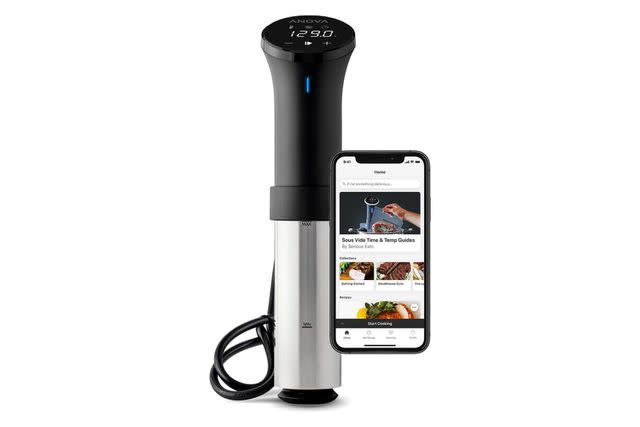
Amazon
What we like: This high-wattage, WiFi-compatible cooker was our highest performer in testing.
What to know: You’ll need to supply your own water container.
A trusted brand in the world of sous vide equipment, Anova offers several models of sous vide cookers within its line of products. This Anova Precision Cooker is the mid-range model in the lineup, and it received high ratings across the board from our testers. This user-friendly machine connects seamlessly to WiFi, allowing you to monitor the progress of your sous vide from anywhere in your home (or outside, depending on your WiFi reach). It also has a handy Anova Culinary app with step-by-step sous vide recipes to try.
When we tested the Anova Precision Cooker, we were thoroughly impressed with its performance. The setup instructions were simple and straightforward, and the machine easily clipped onto the water container and held a steady and reliable temperature. We also liked the machine’s easy-to-read digital display and helpful alarm system that beeps once the water reaches the desired temp. When cooking our chicken, we found that this Anova cooker imparted the most flavor out of all the sous vide machines we tried. It also gave the chicken a great texture—“firm enough for a good bite and not too mushy and soft,” according to one of our testers.
Although the price point is a bit steep, we think the Anova Precision is a solid choice for home cooks of all skill levels. For comparison purposes, we also tested the Anova Culinary Sous Vide Precision Cooker Nano, a less expensive model that didn’t quite make our list of faves. While the Nano performed decently, it lacks some of the flourishes of the Precision—for example, the Nano has Bluetooth connectivity but not WiFi. We think the Nano might be better suited for someone who requires a little less power and precision and who isn’t as married to high-tech features.
Dimensions: 3.1”D x 3.1”W x 12.8”H | Wattage: 1,000 watts | Max Water Temperature: 197°F
Best Budget-Friendly: Inkbird Sous Vide Cooker
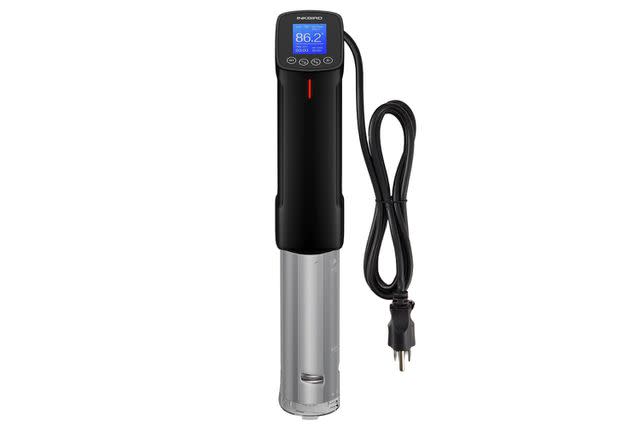
Amazon
What we like: This sous vide cooker packs plenty of power into an affordable price point.
What to know: Setup can be challenging.
Compared to many slow cookers on the market, the Inkbird is on the lower end of the pricing scale—but that doesn’t mean it skimps on power. This 1,000-watt machine performed just as well as the more expensive models we tested, and we think it’s a great option for budget-minded cooks. The Inkbird also comes with a downloadable app, and the device itself can connect to WiFi.
During our testing, the Inkbird held the water bath at a consistently accurate temperature, which didn’t drop at all when we added our sealed bags of chicken. After cooking, our chicken turned out juicy and tender, although we’d recommend giving it a good sear in a skillet before digging in.
One hitch, however, is that the Inkbird is a little more challenging to set up than some other machines, so you may want to give yourself some extra time at the beginning to become acclimated with it. Additionally, the digital display has buttons, which are less sensitive than the touchscreens of some of the more upscale models. That said, given the price point, the Inkbird remains an incredible value for the money.
Dimensions: 2.36"D x 2.36"W x 16.14"H | Wattage: 1,000 watts | Max Water Temperature: 210°F
Best Upgrade: Anova Sous Vide Precision Cooker Pro
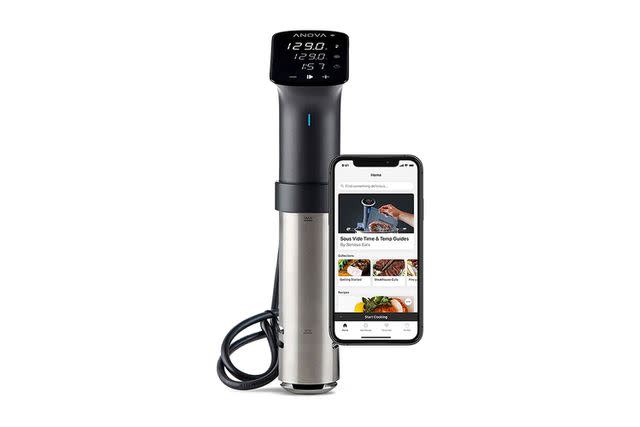
Amazon
What we like: A powerful machine that can cook for hours.
What to know: This model is on the expensive side, and it’s also larger than Anova’s other cookers.
For cooks looking to take on large-format feasts or who use kitchen gadgets more rigorously, the Anova Precision Pro Cooker can be a great investment. An upgrade from the Anova Precision Cooker, this Pro version boasts a higher wattage of 1,200, making it more equipped to handle bigger tasks.
The Precision Pro is entirely made of metal, instead of metal and plastic, and it definitely shows. This machine can also cook continuously for up to 10,000 hours, which is twice as long as the aforementioned Anova Precision—and about three times as long as the Anova Precision Nano model. The touchscreen LED digital display is informative and easy to read, displaying the current water temperature, the target temperature and a timer.
Overall, we found this machine to be very easy to use, and despite the high price point, we think it’s a great beginner-friendly option. One thing we’ll note: At nearly 14 inches tall, the Pro takes up more space than Anova’s less expensive models, so those with smaller kitchens may want to keep this in mind if storage is an issue.
Dimensions: 3.46"D x 2.6"W x 13.78"H | Wattage: 1,200 watts | Max Water Temperature: 197°F
Best for Beginners: Instant Pot Accu Slim Sous Vide Precision Cooker
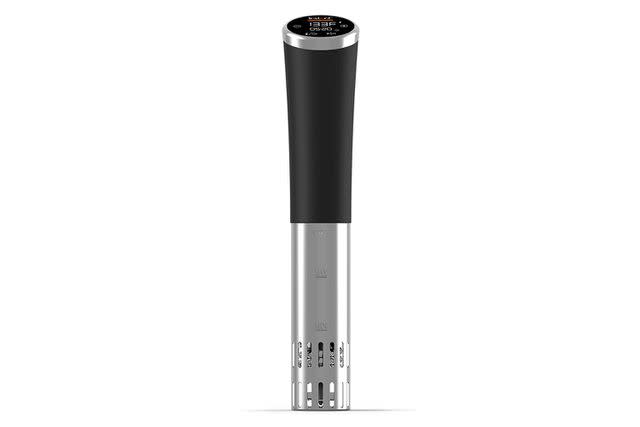
Amazon
What we like: A slightly less powerful cooker that’s a good fit for novice sous vide cooks.
What to know: This cooker lacks WiFi and Bluetooth connectivity.
Made by the same brand that produces the popular Instant Pot, the Instant Pot Accu Slim is an entry-level machine ideal for those trying their hand at sous vide for the first time. While it lacks some of the embellishments of other models, such as Bluetooth or WiFi connections, it’s very easy to use. The machine heats quickly and clamps onto the vessel with ease. It also has a digital touchscreen that displays the temperature and time settings.
At 800 watts, the Accu Slim was the least powerful out of all the sous vide cookers we tested, so we weren’t particularly “wowed” with the performance. While the machine held the water at a consistent temperature, the circulation wasn’t great, and our chicken breast turned out a bit bland and unevenly textured. That being said, we think the Accu Slim is a decent value for the money, and it makes a good starting point for beginners to dip their toes into the sous vide sphere.
Dimensions: 5.1''D x 2.6''W x 13.5''H | Wattage: 800 watts | Max Water Temperature: N/A
Best Overall Sous Vide Water Oven: Crock-Pot Programmable 7-Quart Cook & Carry Slow Cooker with Sous Vide
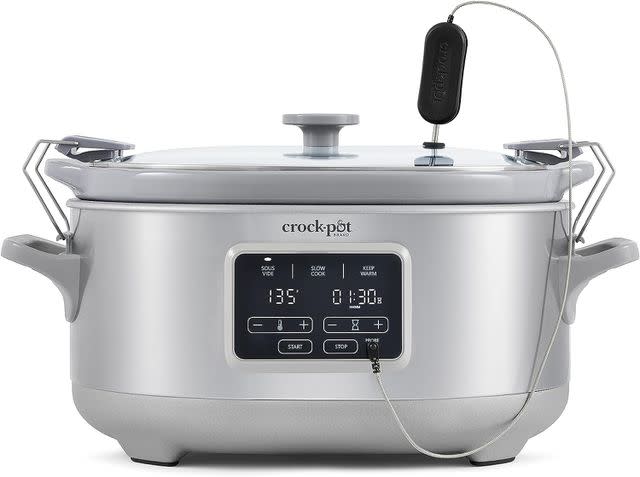
Amazon
What we like: This combination sous vide cooker and slow cooker is convenient and easy to use.
What to know: The glass lid and plastic locking handles feel a bit low in quality.
When it comes to sous vide water ovens, this programmable CrockPot Cook & Carry Slow Cooker with Sous Vide is our top overall pick. It earned high marks in our testing due to its ease of use and its seamless design, which doubles as both a slow cooker and a sous vide machine. This 7-quart cooker takes up less than 2 square feet of counter space, and it’s lightweight enough that it can be moved around with ease. It boasts a temperature range between 110ºF and 190ºF with cook times of 5 minutes to 30 hours.
While testing this machine, we noticed minimal water evaporation, and the Crock-Pot quickly reached our target temps. We found that the alerts were loud enough to be heard in just about any room of the house, notifying us when the preheating and cooking processes were complete.
We used the sous vide setting to cook bone-in beef short ribs for 30 hours at 150ºF. Although we felt it would have benefited from a longer cooking time, the ribs still came out tender and flavorful. We also tried out the slow cooker function, cooking a pot roast with vegetables on low for 8 hours, and it performed equally well.
To drain the water from the machine after using the sous vide, you'll need to lift the ceramic cooking vessel out of the base. We used 6 quarts of water in our test and had no issues lifting it out. However, due to the small handles on the cookware, we'll note that this could be a difficult task if the vessel is any fuller.
Overall, using the machine was intuitive, the instructions were clear and concise, and the temperature was accurate within 1 to 2 degrees. While the unit doesn’t actually circulate water during the sous vide cooking process, this didn’t seem to affect the temperature readings.
Dimensions: 17.5”D x 11.37”W x 9.13”H | Wattage: Not listed | Max Water Temperature: 190ºF
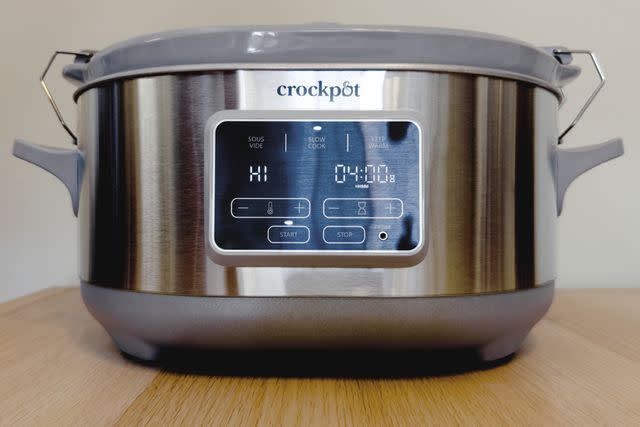
EatingWell / Eric Spicher
Best Splurge Sous Vide Water Oven: VacPak-It SVC100 2.6 Gallon Thermal Sous Vide Circulator
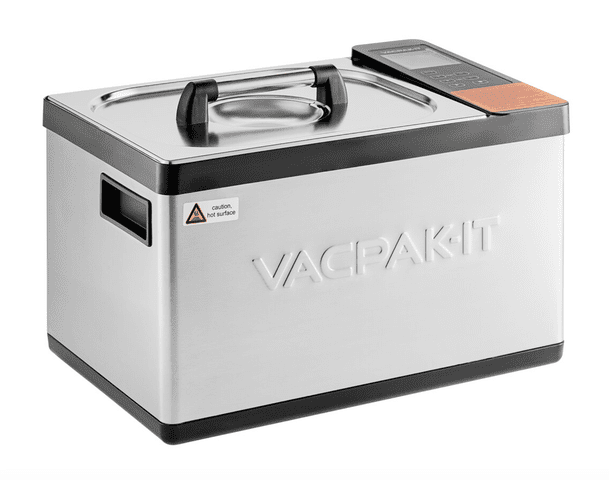
WebstaurantStore
What we like: It’s an all-in-one water oven with very accurate temperature readings.
What to know: It’s heavy, so it can be difficult to drain.
We chose the VacPak-It as our best splurge option because of its overall performance, accuracy and ease of use. Since it is an all-in-one unit, it’s a little on the bulky side, but we think it's worth the countertop real estate.
During our testing, we found that the alerts are very audible, and you can hear them in every room. (In our case, it was a 1,250-square-foot apartment.) We were impressed that even though the temperature can reach a maximum of 203ºF, the side walls remain warm to the touch; the lid can become extremely hot.
We liked how the control panel was intuitive and straightforward. When adjusting the time and temperature settings, you simply push the plus or minus buttons and the stop and start buttons, and you can also alternate between Fahrenheit and Celsius. We'll note that, while the built-in handles make it easy to maneuver, it can be heavy and difficult to move if you’re far from the sink (or wherever you're going to drain the water).
This was one of the most accurate units we tested, displaying temperature readings of less than 1 degree difference with minor fluctuations. While the primary purpose of this machine is sous vide cooking, it is also versatile enough for preserving, canning and preparing various types of meals, making it an excellent choice for culinary enthusiasts looking for hassle-free and precision cooking.
Dimensions: 10.5”D x 16”W x 10”H | Wattage: 650 watts | Max Water Temperature: 203ºF
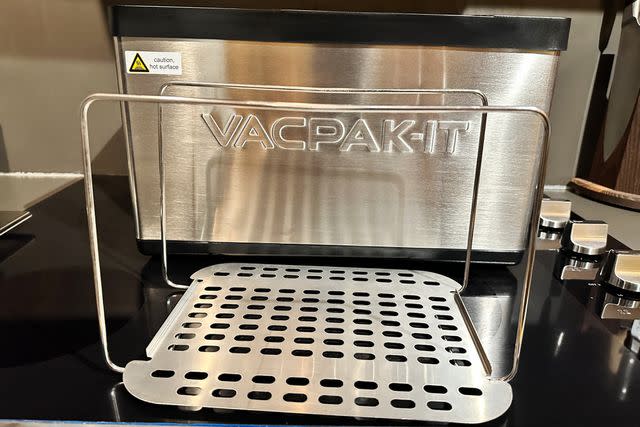
EatingWell / Joe Morales
The Bottom Line: The Best Sous Vide Cooker
Our top pick, the Anova Culinary Sous Vide Precision Cooker, produces expertly cooked foods and boasts great bonus features like WiFi connectivity and 5,000 hours of continuous cooking time (view at Amazon). We also loved the Inkbird Sous Vide Cooker, which includes an LED touchscreen, WiFi capabilities and a convenient app, all at an accessible price point (view at Amazon). And if you're looking for a versatile sous vide water oven that doubles as a slow cooker, it's hard to do better than the Crock-Pot Cook & Carry Slow Cooker with Sous Vide (view at Amazon).
Choosing a Sous Vide Machine
Is It Easy to Use?
Today’s sous vide machines offer everything from built-in timers to LED touchscreens to WiFi capabilities that allow you to monitor your cooking remotely. These bonus features are designed to make the machines easier to use, but they may be a bit intimidating to those new to sous vide cooking—and they can also increase the price of the machine. If you’re an avid cook and intend to use your sous vide cooker frequently, you may find these features are worth the money. But if you’re just starting on your sous vide journey, you may decide to forgo some of the bells and whistles in favor of a more straightforward, no-frills machine.
How Does It Perform?
With sous vide machines, precision is key. “It all boils down to the accuracy [of the temperature] of the cooking water bath,” Rosendale says. “The quality of the machine is very important to ensure cooking time and quality.” In addition to accuracy, you should also consider wattage, as powerful, higher-wattage machines will circulate more water and heat it more rapidly. This can help if you’re cooking large-format items, such as turkey or brisket. But keep in mind that the more powerful the machine, the higher the price tag, so consider this as you plan your purchase.
Look At the Design
One of the main things to consider is the design of the sous vide cooker you want. The sous vide water oven is an all-in-one appliance that has a built-in water container, a heating element and circulator vents. The immersion circulator, on the other hand, is a standalone appliance that sits in a water container of your choice. It also has a heating element and circulator vents but is much more compact than the water ovens.
Each device works similarly and is comparable in cooking precision; choosing one over the other often depends on personal preference and storage space. Water ovens tend to be bigger and require additional space, whereas immersion circulators can be placed in drawers. Both are equally portable and can be set up with ease.
Factor In the Price
Depending on the quality of the model you’re considering and the features that matter to you, expect to spend between $80 and $400 on a quality immersion circulator-style sous vide machine. “Buy from a reputable brand with good reviews so your circulator will last as long as possible,” says Cole.
Standalone immersion circulators are generally more budget-friendly than the all-inclusive water ovens, so consider your needs and preferences when considering the price. Knowing your cooking habits, frequency of use and the desired features you require will help you make a more informed decision based on functionality and budget.
Our Sous Vide Machine Tests
To find the best sous vide machines, we rounded up 21 popular sous vide models and enlisted a team of chefs and seasoned product testers to try them out. Each sous vide machine was assembled per the manufacturer’s instructions. The machine was then attached to a Cambro container filled with cold tap water and set to 165°F. Our testers recorded the amount of time it took for the device to bring the water up to temperature, and the water temperature was then evaluated for accuracy. We placed bone-in, skin-on chicken breasts into vacuum-sealed bags, lowered them into the water bath and cooked them for an hour and a half. After the cooking period, we checked the internal temperature of the chicken to make sure it had reached 165°F.
During our tests, we evaluated how accurate the temperature readings were and how easy the device was to use, including programming, timer setting and reaching target temperatures. We also measured the time it took for the water to reach the minimum and maximum temperature settings and used a secondary thermometer to test the sous vide cooker's accuracy.
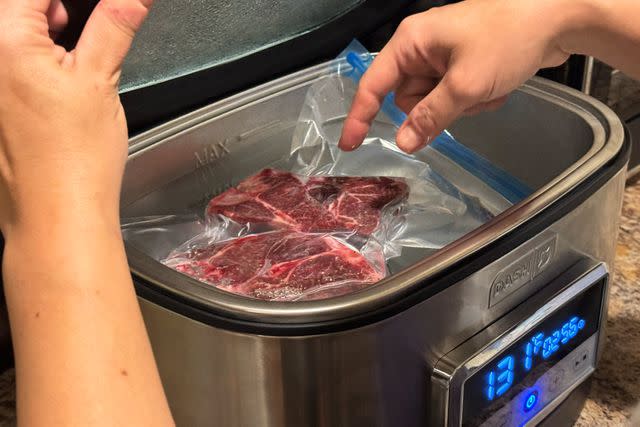
EatingWell / Kimberly Souza
We Also Considered
Anova Culinary Sous Vide Precision Cooker Nano ($99 at Amazon): The Nano was very similar to our top overall choice, the Anova Culinary Precision Cooker, but it had fewer bells and whistles and considerably lower wattage. It also had Bluetooth capability but no WiFi capability.
All-Clad Sous Vide Professional Immersion Circulator Slow Cooker ($210 at Amazon): This model falls around the same price point as our top pick, and while the All-Clad did perform well in testing, it lacked some of the features that the Anova cooker offered, like WiFi or Bluetooth connectivity and a touchscreen.
Inkbird Sous Vide Water Oven ($210 at Amazon): When testing the Inkbird water oven, we found it had a few minor quirks that made it a little more challenging to operate than our best overall Crock-Pot cook & Carry Slow Cooker with Sous Vide. The Inkbird is comparable to a large slow cooker, but using the settings was tricky.
Dash Chef Series Digital Sous Vide Bath ($150 at Amazon): This water oven touched on all the points our other water ovens did. When the water reaches its target temperature, the cooking timer starts, and once the timer runs out, the sous vide bath shuts down. Each of these points is crucial for accurate cooking times. However, we found this machine to be a bit cumbersome, and the sides got quite hot when cooking at higher temperatures.
Common Questions
Is sous vide cooking good for you?
Sous vide cooking, says Shen, offers numerous nutritional benefits, and it preserves nutrients in food more than some other cooking methods. “One study showed that legumes, such as peas and lentils, cooked in sous vide contained higher levels of minerals like iron, copper, zinc, magnesium and potassium,” Shen says. Additionally, she explains, since sous vide cooking can be conducted without adding extra oils or fats, it can help reduce overall fat and calorie intake without adversely impacting the taste of the food.
What else do you need to get started with sous vide?
For most of these sous vide machines, you will need a stockpot or a large, heat-safe plastic container, such as a Cambro, to hold the water. You’ll also need a vacuum sealer with freezer-safe bags to package and seal the food you cook. To make the cooking process as seamless as possible, Cole recommends using sous vide magnets. “You want to make sure your food stays submerged so it’s surrounded by the temperature-controlled water the entire time it cooks,” she says. “Sous vide magnets are a great way to keep your food from floating.” Once the sous vide process has ended, Cole recommends placing your proteins into a cast-iron skillet to give them that perfect sear.
What is a sous vide water oven?
As mentioned, many sous vide cookers require you to supply a container full of water to place the appliance in. However, a sous vide water oven is an all-in-one cooking appliance that includes its own water basin. These water ovens are similar to sous vide circulators but are self-contained, whereas circulators can be placed into any container of any size.
Our Trusted Expertise
Hannah Selinger is a James Beard Award-nominated writer who has written about food and drinks since 2015. A former sommelier and a graduate of the French Culinary Institute, Hannah has worked for some of New York’s top restaurant groups. To write this article, she drew on a thorough analysis and test of 16 prominent sous vide products on the market.
This article was updated by Joe Morales, a senior commerce editor and trained chef who specializes in home, kitchen and product reviews. He participated in testing these sous vide cookers and incorporated information from our lab insights when updating this article.
We also consulted the following experts for their insights about sous vide cookers:
Sherrie Shen, M.S., R.D.N, C.D.N., Registered Dietitian in New York
Chelsea Cole is a food blogger and author of cookbooks Everyday Sous Vide and Sous Vide Meal Prep.
Rich Rosendale, Certified Master Chef and Co-Founder of Atlanta, Georgia’s R3 Rosendale Concepts.
This article was edited by Kayleigh Drake, a former full-time baker and current EatingWell commerce editor and contributor to publications such as Food & Wine, The Spruce Eats and Simply Recipes, and it was reviewed by Brierley Horton, M.S., RD, senior commerce editor, who has 15 years of experience reporting, writing and editing nutrition and health content.
Read the original article on Eating Well.

